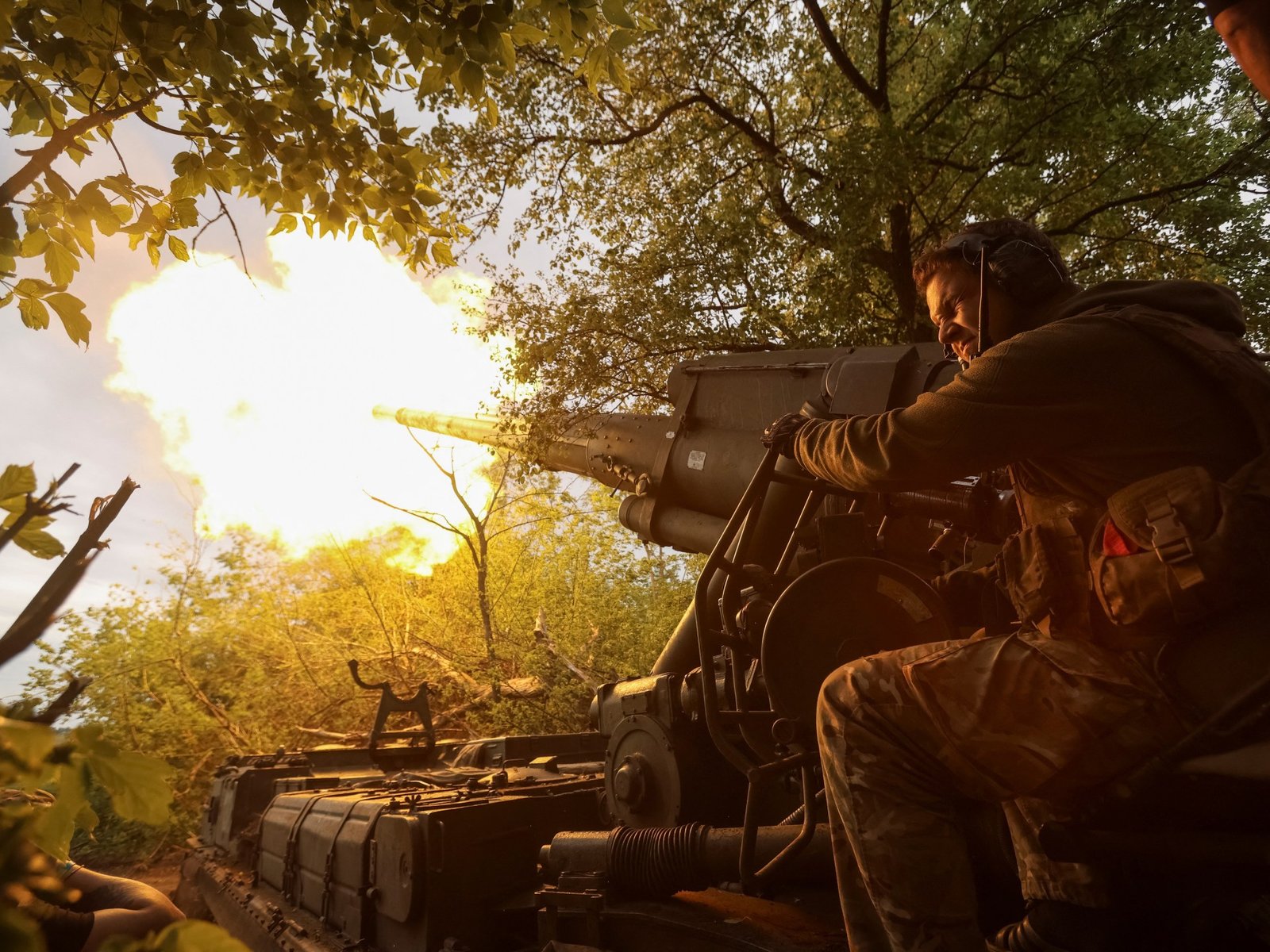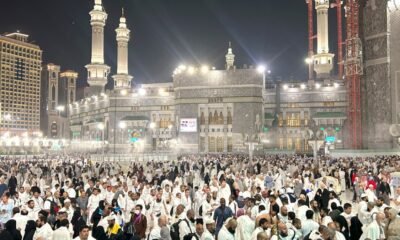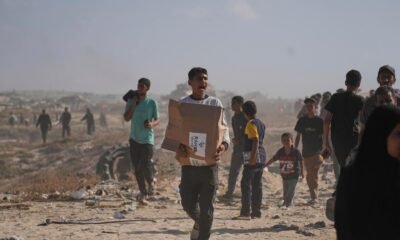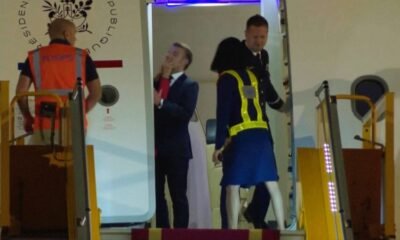Conflict Zones
‘Someone’s listening’: Fear and longing in Syria’s al-Hol detention camp | ISIL/ISIS News

Many of the camp’s detainees had opted to stay home that dusty day, but Asma decided to brave the elements and take advantage of a less crowded marketplace.
With her four children close by her side, she scanned the underwhelming selection of vegetables on display at a small stall, weighing up what dishes she could muster with the limited options on sale.
Asma’s oldest child, a precocious nine-year-old girl with a red-ribboned headband and a pink tracksuit cradled the youngest child, a cherubic one-year-old girl swaddled in a padded jacket.
She adjusted the hood of her sister’s jacket, which had slipped down, causing the toddler to squirm as the dust swirled around her face.
She pulled her little sister towards her chest protectively, drawing a warm nod of approval from her mother.
Asma spends most of her days with her children because she doesn’t feel the education facilities in the camp meet their needs.
As she spoke, her two sons erupted into a spontaneous playfight.
Her expression betrayed a deep melancholy. “It’s difficult to raise children here,” she admitted, her gaze lowered.

The monotony of daily life in the camp, she explained, can often lead to the children fighting and she can find it difficult to control her boys.
On top of that, in her seven years in the camp, Asma has seen prices rise to the point that it is now difficult to buy enough food to feed her growing children.
NGOs distribute daily food rations in al-Hol, but many detainees supplement these ready-made meals and basic ingredients with fresh produce from the market, using money sent by relatives or earned from jobs at the camp’s medical and education facilities operated by NGOs.
Asma’s family has lived through the camp’s most turbulent period, which saw more than 100 homicides from 2020 to 2022 and left a deep psychological impact on the camp’s children, who make up more than half of its population.
In 2021, according to Save the Children, two residents were killed every week, making the camp, per capita, one of the most dangerous places in the world to be a child.
It’s a period that Abed, an Iraqi Turkmen welder from Mosul who preferred to give only one name, kept his four children inside their tent at all times.
When Al Jazeera met 39-year-old Abed, he was working under the shelter of the family repair shop on a side street off the market. The shop, cobbled together from pieces of wood and plastic sheeting, services any machinery that camp detainees need fixed.
He guided his adult son, who is in his early 20s, methodically through a complex welding process, the two smiling at each other as they shared a private joke and the howling wind carried their words out of earshot.

Abed picked up a welding torch as his son held a piece of metal in place with a pair of tongs.
He has taught his children his trade, but that, he said, is just so they can “survive day-to-day”, adding that it will not give them the tools to enjoy a full and fulfilling life.
“My children’s future is gone,” Abed said with a hint of bitterness in his voice. “They’ve missed too much school.”
Several aid organisations run education facilities, but suspected ISIL agents have been known to attack them, so Abed feels it is safer to keep his children away until they can go home.
“We had a good life in Mosul. My children went to school, and everything was fine, but now,” he took a deep breath, “too much time has passed.”
“That’s hard to swallow as a parent because school is everything”.
Conflict Zones
Ballet helps fight war fatigue in Ukraine’s front-line Kharkiv city | Russia-Ukraine war

In the Ukrainian city of Kharkiv, escaping the war with Russia is nearly impossible.
On certain days, when the wind shifts, residents of this historic city can hear the distant rumble of artillery fire from the front line, some 30km (18.5 miles) away.
Most nights, Russian kamikaze drones packed with explosives buzz overhead as parents put their children to bed.
Three years since Russia’s invasion of Ukraine, the unrelenting war exerts a heavy psychological burden on many in Kharkiv. Yet, there is a place in the city where, for a few fleeting hours, the war seems to vanish.
Beneath the Kharkiv National Academic Opera and Ballet Theatre, in a dim, brick-walled basement, a dance company has established a refuge from drones and bombs – a space where audiences can lose themselves in performances of classic ballets.
In April, this underground venue hosted performances of Chopiniana, an early 20th-century ballet set to the music of Frederic Chopin. Despite the improvised setting, the ballet was staged with full classical grandeur, complete with corps de ballet and orchestra.

It marked a significant milestone for Kharkiv’s cultural life: the first complete classical ballet performance in the city since February 2022, when Russian troops launched their invasion of Ukraine.
“In spite of everything – the fact that bombs are flying, drones, and everything else – we can give a gift of something wonderful to people,” said Antonina Radiievska, artistic director of Opera East, the ballet company behind the production.
“They can come and, even if it’s just for an hour or two, completely immerse themselves in a different world.”
Despite Ukraine’s rich tradition in classical ballet, the art form now seems far removed from the everyday existence of Ukrainians living through war. Daily routines revolve around monitoring apps for drone alerts, sleeping on metro station floors to escape air raids, or seeking news of loved ones on the front line. Pirouettes, pas de deux and chiffon tutus feel worlds away.
Nevertheless, the journey of Kharkiv’s ballet through wartime reflects the ways in which Ukrainian society has adapted and evolved.
On February 23, 2022, the National Academic Opera and Ballet Theatre staged a performance of the ballet Giselle. The next day, Russia launched its full-scale invasion. As Moscow’s forces advanced towards Kharkiv and threatened to seize the city, the theatre closed its doors and much of the ballet troupe departed.
Some regrouped in Slovakia and Lithuania, mounting ballet productions abroad with assistance from European sponsors.

By 2023, although the conflict ground on, the situation in Kharkiv, in Ukraine’s northeast, had stabilised after Russian ground troops withdrew. A new realisation took hold – this was a long-term reality. Locals began referring to the city, and themselves, with the Ukrainian word “nezlamniy”, meaning invincible.
That year, work began on transforming the theatre’s basement into a performance venue. By October 2023, it was being used for rehearsals. The following spring, authorities permitted the theatre to admit audiences, and small-scale ballet performances, including children’s concerts, resumed.
The revival of Chopiniana marked the next chapter in Kharkiv’s wartime cultural journey.
Staging a classical opera again signals that Ukraine endures, says Igor Tuluzov, director-general of Opera East. “We are demonstrating to the world that we really are a self-sufficient state, independent, in all its aspects, including cultural independence,” he said.
The auditorium now seats 400 people on stackable chairs, compared with the 1,750 seats in the main theatre above, where the plush mustard seats remain empty.
The stage is a quarter the size of the main one. Grey-painted bricks, concrete floors, and exposed pipes and wiring form a stark contrast to the varnished hardwood and marble of the theatre above. The basement’s acoustics, performers say, fall short of the cavernous main auditorium.
For artistic director Radiievska, however, the most important thing is that, after a long pause, she and her troupe can once again perform for a live audience.
“It means, you know, life,” she said. “An artist cannot exist without the stage, without creativity, without dance or song. It’s like a rebirth.”
Conflict Zones
Sudan Paramilitary Claims Key Gains in Kordofan; Fighting Intensifies Near Khartoum

Khartoum, May 30, 2025 — Rapid Support Forces (RSF) deputy leader Abdel Rahim Daglo announced on Friday that RSF fighters would press their eastward advance toward Khartoum, claiming “great victories” in several strategic towns across Kordofan. Addressing troops at an undisclosed location, Daglo said that all armed groups within the Tasis coalition had joined his paramilitary ranks and were now operating in concert with the RSF.
According to Daglo, RSF units seized control of Al-Dubaibat and Al-Hammadi in South Kordofan state, as well as Al-Khawi in neighboring West Kordofan. “Our fighters have secured these areas after intense clashes with Sudanese Armed Forces (SAF) units and allied militias,” Daglo declared, adding that the momentum would not wane until the capital was within reach.
Sudan’s army, however, downplayed recent RSF advances as part of a “reorganization” campaign. A senior ally of the SAF—also the governor of Darfur—insisted that the military was regrouping and fortified its positions to counter what he described as “a temporary setback.” He maintained that the SAF’s strategic reserves remained intact and that front-line forces were being repositioned to mount a sustained defense of Khartoum.
As fighting has spread northward, the humanitarian situation in Khartoum has deteriorated sharply. With basic services all but collapsed, a deadly cholera outbreak has emerged in the densely populated capital. Aid agencies warn that the impending rainy season could exacerbate sanitation challenges, fueling further disease transmission. The United Nations has labeled the crisis “the world’s worst humanitarian emergency,” citing over 25,000 confirmed deaths and more than 3 million internally displaced persons since April.
International pressure has also mounted on Sudan’s transitional government. In late May, Washington imposed sanctions on Sudanese military leaders for the “alleged use of chemical weapons” against civilians. In response, the government announced a national investigation into the claims—a move it said was aimed at preserving Sudan’s international standing amid intensifying conflict.
With both sides entrenching their positions around Khartoum, observers warn that a protracted stalemate could unleash further civilian suffering. The RSF’s pledge to advance eastward has raised concerns that front-line engagements may spill into densely populated suburbs, where millions have already endured weeks of intermittent shelling and aerial bombardments. For now, the fate of Khartoum—and the broader prospects for peace—remain uncertain as paramilitary and army forces brace for a decisive showdown.
Conflict Zones
Two killed in Russian attacks on Ukraine before possible talks in Turkiye | Russia-Ukraine war News

Russia has confirmed it will send a delegation to Istanbul, but Kyiv has not yet accepted the proposal.
Russian drone and missile attacks on Ukraine have killed at least two people, according to officials, as Ukraine ordered the evacuation of 11 more villages in its Sumy region bordering Russia.
Russian troops launched an estimated 109 drones and five missiles across Ukraine on Friday and overnight, the Ukrainian air force said on Saturday, adding that three of the missiles and 42 drones were destroyed and another 30 drones failed to reach their targets without causing damage.
The attacks came amid uncertainty over whether Kyiv will take part in a new round of peace talks early next week in Istanbul.
In the Russian attacks on Saturday, a child was killed in a strike on the front-line village of Dolynka in the Zaporizhia region, and another was injured, Zaporizhia’s Governor Ivan Fedorov said.
“One house was destroyed. The shockwave from the blast also damaged several other houses, cars, and outbuildings,” Fedorov wrote on Telegram.
A man was also killed by Russian shelling in Ukraine’s Kherson region, Governor Oleksandr Prokudin wrote on Telegram.
Moscow did not comment on either attack.
Meanwhile, authorities in Ukraine’s Sumy region said they were evacuating 11 villages within a roughly 30-kilometre (19-mile) range from the Russian border.
“The decision was made in view of the constant threat to civilian life as a result of shelling of border communities,” the regional administration said on social media.
Ukrainian President Volodymyr Zelenskyy has said some 50,000 Russian troops have amassed in the area with the intention of launching an offensive to carve out a buffer zone inside Ukrainian territory.
Ukraine’s top army chief, Oleksandr Syrskii, said on Saturday that Russian forces were focusing their main offensive efforts on Pokrovsk, Torets and Lyman in the Donetsk region, as well as the Sumy border area.
Syrskii added that Ukrainian forces are still holding territory in Russia’s Kursk region – a statement Moscow has repeatedly denied.
The evacuations and attacks came just two days before a possible meeting between Kyiv and Moscow in Istanbul, as Washington called on both countries to end the three-year war.
Russia has confirmed it will send a delegation, but Kyiv has not yet accepted the proposal, warning the talks would not yield results unless the Kremlin provided its peace terms in advance.
Zelenskyy said Saturday it was still not clear what Moscow was planning to achieve at the meeting and that so far, it did not “look very serious”.
-

 Africa4 days ago
Africa4 days agoSurvivor of Liverpool car ramming talks of shock and panic
-

 Sports3 days ago
Sports3 days agoThe Knicks are bringing hope and title dreams back to New York after years in the doldrums
-

 Lifestyle3 days ago
Lifestyle3 days agoChildren and careers: Talking to kids about what they want to be when they grow up
-

 Lifestyle4 days ago
Lifestyle4 days agoHow to decorate a patio, balcony or other small outdoor space
-

 Lifestyle4 days ago
Lifestyle4 days agoFaizan Zaki hopes to go from spelling bee runner-up to champ
-

 Middle East5 days ago
Middle East5 days agoHajj pilgrimage in Saudi Arabia to begin on June 4 | Religion News
-

 Middle East4 days ago
Middle East4 days agoGaza’s aid system isn’t broken. It’s working exactly as designed | Humanitarian Crises
-

 Europe5 days ago
Europe5 days agoMacron’s marital shove disappears from French airwaves




